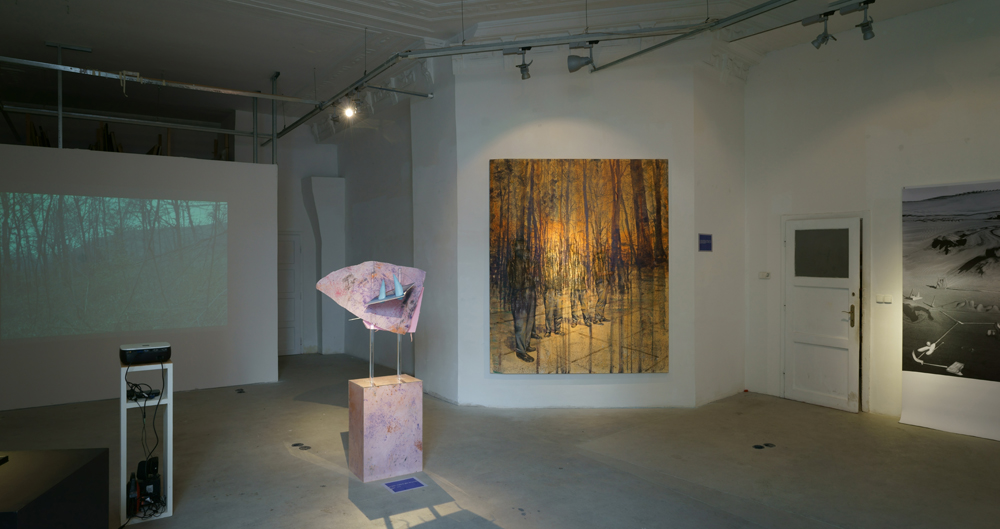FUTURUM PERFECTUM
FKSE, Budapest,From 20-th. of February to 23-th. of Marc 2018
Curated by Mário Z Nemes
FUTURUM PERFECTUM
Postapocalyptic thought contains an anthropological and historical paradox, because it allows human rationality to observe itself after its own „disappearance”, through a posthuman optic. According to Eva Horn, this is equivalent to the apocalyptic fantasy of a futurum perfectum, in which the future is exposed as catastrophe within a present already sutured with the void of an abyssal future. The anthropological paradox emerges when we reflect upon the following question: are humans capable of reflecting on their own disappearance? Furthermore, how may the experience of disappearance and extinction be integrated into experience, if at all? Furthermore, does the futural survivor of extinction have any historicity, is it a historical being, if the human world has been reduced to a state of ruination? Can history survive the apocalypse? Or, as Walter Benjamin held, does natural history remain the sole form of historicity in the wake of catastrophe, in which humans come to be reintegrated in the form of geological layers and mineral elements?
Catastrophe exerts an irresistible, exasperating allure upon us. „With allure”, writes Graham Harman, „the human tends toward the mineral kingdom once more.” The FUTURUM PERFECTUM exhibition attempts to uncover the content of the postapocalyptic paradox we have outlined above, in the context of an inorganic visual poetic context. In the center of the exhibit is Péter Lichter’s Fagyott május, an experimental horror film that reflects upon the media strategies of the Budapest School of horror painting. Over the past decade the Budapest School has engaged in subversive representations of bodies, refining a truly dazzling practice of aesthetic dehumanization, but Lichter’s film presents viewers with a new dimension of horror aesthetics, for what we see before us is a landscape evacuated of all human presence. What we are confronted with is an experiment in Anthropocene art, art without human protagonists. The exhibition presents us with an ambivalent tension between aesthetization and materiality, as the ethereal, artificial atmosphere of Lichter’s film is interestingly brought into contrast with a very real and palpable materiality. Within these aestheticized landscapes residual forms are contrasted with the apparent formlessness of nature, albeit we cannot forget that materiality itself is never clean, pure or untouched. In their various ways, the works of Márk Fridvalszki, Attila Szűcs, Zsófia Keresztes, László Győrffy and Csaba Kis Róka represent materiality as always already constructed, artificial and impure. Matter is dirty, hence art attuned to the call of matter must rid itself of any idealistic attachment to a supposedly untouched, unblemished natural realm. Through a process of decay and decline, nature exposes the simulation of landscapes through a proliferation of material and objective simulations. No longer can we identify any essence within nature, a non-substantial morass already mixed together with technologies, codes, constructs and structures. Nature, landscape, matter: these are all nothing more than elements of a stage, a theater in which emptiness mimes itself into presence in the context of an aesthetic strategy, a performance within which the role of humans comes to be ever more restricted. Neither actors nor viewers, we are doomed to disappear from the theater of Being.
FUTURUM PERFECTUM
A posztapokaliptikus gondolkodásban benne rejlik egy antropológiai és történeti paradoxon, hiszen egy olyan optikát kínál fel, melyen keresztül az ember visszanéz önmagára, mégpedig saját „bevégződése” után. Eva Horn kultúratudós szerint ez a futurum perfectum apokaliptikus fantáziája, melynek tárgya a jövő mint katasztrófa. Az antropológiai paradoxon ott képződik meg, hogy vajon az ember képes-e kívülről reflektálni önmaga „eltűnését”, vagyis mennyiben és miként emberi még a túlélő tekintete? Illetve van-e története/történelme ennek a túlélőnek, ha a jelentésadó emberi világ legfeljebb csak romként hozzáférhető? Vagy valójában már csak természettörténet adódik számára, ahogy azt Walter Benjamin elképzelte, melybe az ember és a történeti világ geológiai üledékként integrálódik vissza?
Ellenállhatatlan vonzerőt gyakorol ránk a katasztrófa. Mint Graham Harman írja, „a vonzerő által az ember mintha ismét visszatérne az ásványi világba.” A FUTURUM PERFECTUM című kiállítás a fenti kérdésekre próbál választ találni, miközben a posztapokaliptikus paradoxon képzőművészeti, illetve képpoétikai kontextusát vizsgálja. A tárlat középpontjában Lichter Péter Fagyott május című kísérleti horrorfilmje áll, melyet a Budapest Horror-szcénához tartozó képzőművészek és alkalmi szövetségeseik reflektálnak különböző mediális stratégiákkal. A Budapest Horrorhoz leginkább a testábrázolás szubverzív formáit társította eddig a közönség, de a FUTURUM PERFECTUM a horroresztétika egy másik dimenzióját hangsúlyozza ki, hiszen Lichter alkotása az ember nélküli táj reprezentálhatóságának kérdését kutatja, miszerint létezhet-e tája az „utolsó embernek”, hogyan alakul természet és tájkép kapcsolata egy emberi világ nélküli kondíciójában? A tárlat feszültségét az esztétizáció és a materialitás közti ambivalencia szolgáltatja, mert az ember nélküli tájaknak Lichter filmjében van egyfajta stilizált, éteri már-már szimulákrumszerű lebegése, ugyanakkor ezt a lebegést megtörik az anyagiság hullámai. A tájkép esztétizált maradványformái tehát a természet formátlan anyagiságával szembesítődnek, noha folyamatosan tudatosítani kell, hogy ez az anyagiság se rendelkezik semmilyen tiszta evidenciával, hiszen Fridvalszki Márk, Szűcs Attila, Keresztes Zsófia, Győrffy László és Kis Róka Csaba művei a materialitás művi, konstruált és/vagy digitális karakterét hangsúlyozzák ki. A természet végidején a tájkép szimulációját az anyag és a tárgyak szimulációja egészíti ki, hiszen nincsen már tiszta „lényege” ennek a természetnek, mert megkülönböztethetelenül elkeveredik a technológia különböző formáival, kódjaival és struktúráival. A természet, táj és anyag motívumai tehát egy színházi előadás motívumait alkotják, ahol az állandó és kölcsönös „mímelés” válik a meghatározó esztétikai stratégiává, miközben az ember nemhogy a szereplője, de mintha a nézője se lehetne már ennek az előadásnak.
Pics from the installation:











